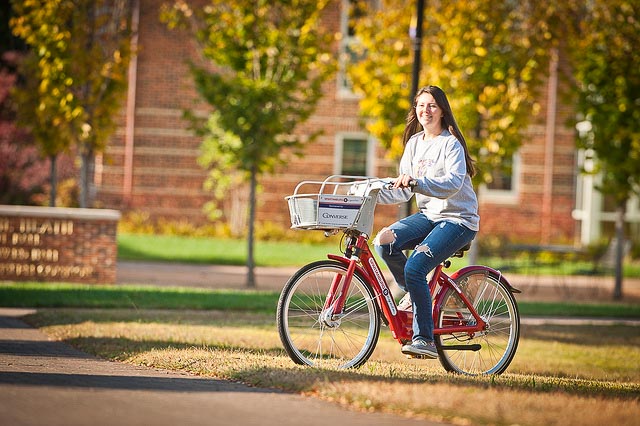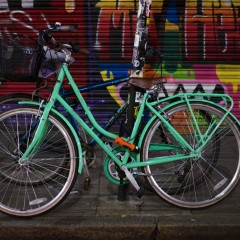Bike-share programs bear an uncanny resemblance to social media platforms.
Just as social media sites open up lines of communication between users, bike-sharing programs provide transportation links between docking stations.
These systems are configured as networks, which means that the number of potential connections increases exponentially as systems grow. For example, a social media platform with 100 users – which lets each of its users contact 99 others – opens up just shy of 10,000 lines of communication. A site with 200 users, meanwhile, opens up around 40,000 lines of communication, as it lets 200 users contact 199 others
The same pattern holds in bike-share programs: a system with twice the docking stations allows users to make four times as many different trips.
The total volume of activity can also increase exponentially, because new social media users and bike-share kiosks positively affect the activity of other users and kiosks. A larger social media platform allows existing users to connect with more friends, relatives, and acquaintances. In other words, the social media platform becomes more useful.
New docking stations, likewise, contribute to the appeal of bike share at every location in the network. When new kiosks get added, prospective riders at existing stations can use bike share to travel to a greater array of destinations.
Comparing systems
These secondary effects – which economists dub network externalities – are a double-edged sword. On one hand, they excite the planners and operators of bike share programs immensely: they invite the possibility of exponential growth. But they also present a peculiar challenge. How can the planning community meaningfully compare the success of bike-share systems of different sizes, given the compounding advantages of additional stations?
Because of network effects, we would expect larger systems to not only generate more total ridership but also to experience a larger number of checkouts per kiosk. However, it’s hard to claim that bigger systems are necessarily better than smaller systems when it comes to kiosk placement, network configuration, and the more subtle components of system design, simply because big systems tend to generate more trips.
At first glance, we can’t tell to what extent the volume of trips in a system results from specific design decisions, and to what extent it stems simply from the system’s size. Given this ambiguity, it becomes particularly challenging for planners and operators to identify strategies for improving their systems beyond general expansion.
Challenging expectations
Our recent report looks at several metrics of bike-sharing activity in Austin, Denver, Houston, and Fort Worth. In certain ways, the levels of bike-sharing activity in these four Sunbelt systems align with what we would expect to see from networks of different sizes. The programs in Denver and Austin – the two largest networks – generate far more trips per kiosk (and overall) than the smaller systems in Houston and Fort Worth. The trend suggests that when it comes to bike-share programs, bigger is indeed better.
In other ways, however, the levels of bike activity in the four systems diverge from our expectations.
Austin, for instance, sees a slightly greater number of bike-sharing trips per kiosk than Denver, even though the Colorado capital sports almost twice as many stations as its Texas counterpart.
And the average Houston kiosk generates almost twice the checkouts per kiosk as the average Fort Worth station, even though Houston’s system is slightly smaller.
We glean valuable insight by examining these unexpected differences.
The Austin case illustrates how contextual factors further complicate attempts to compare the success of bike-share programs across cities. Austin’s edge over Denver can be chalked up – at least partially – to climatic differences between the two areas. Our analysis only considers trips made during the first five months of the calendar year, and winter bicycling sounds much more appealing in Texas than in Colorado. (We look at trips made in Austin between January through May of 2015, and Denver trips made during the same months in 2014.)
While considering trips from an annual period could help account for seasonal variation, a larger question remains unanswered. Bike-sharing programs involve different physical climates, populations, built environments, and transportation systems. How can we properly account for the wide array of contextual factors that might influence the volume of activity in these systems?
Houston’s edge over Fort Worth is harder to blame on the weather. While the two cities’ climates aren’t identical, they’re more comparable than that of Denver and Austin. Houston’s bike-sharing program may generate more ridership because of the city’s commitment to providing residents and visitors with the proper infrastructure for active recreation.
Houston has substantially improved its system of parks and trails in recent years, and Houston Bike Share has been sure to place stations in and around these renovated green connectors. These park stations have proved extremely popular: two of these kiosks – those in Hermann Park and near Sabine Bridge – generate more checkouts than those of any kiosk in any of the four cities we examined.
Future expansions
In the coming years, bike-sharing programs around the country will proliferate and expand. Los Angeles and Atlanta – the two largest U.S. metros without bike-share – will roll out programs in 2016. Likewise, the bike-sharing organization in Houston will use funds from the Houston-Galveston Area Council to more than triple the size of the network in the next 18 to 24 months. And Seattle’s Department of Transportation is applying for federal grants to expand its bike-share system. Given the pressing need for alternative modes of transportation in some automobile-oriented cities, as well as the potential for the exponential growth of bike-sharing activity, these developments are exciting.
As cities design and implement larger bike-share programs, they will naturally look to existing programs in other places for inspiration. Planners will closely examine the systems they deem successful, find design strategies that appear to underpin these systems’ success, and implement these strategies in their own cities. This practice is well-intentioned: planners should learn as much as they can from cities confronting similar challenges and pursuing similar goals.
Other metrics
But if the design strategies we implement depend upon the systems we deem successful, we should reconsider how we define and quantify success. With bike-share, as with many other programs, it is tempting to focus on those systems with the largest numbers. However, Sunbelt cities should carefully consider to what extent they model their new and expanding programs after the northeastern programs that generate the most total activity today.
Certainly, New York’s CitiBike and Chicago’s Divvy generate remarkable numbers of trips on both a system-wide and per-kiosk basis. We cannot immediately say, however, whether these levels of activity stem from effective design decisions, the sheer size of the networks, or the dense, transit-oriented fabric of the cities they inhabit. We cannot say, therefore, that the strategies employed in New York – positioning kiosks near transit stations, implementing pricing structures that incentivize extremely short trips – will pave the way to higher levels of bike sharing activity in Sunbelt cities.
Moving forward, the planning community must take contextual factors and system size into account when evaluating bike-sharing programs in different cities. It will not be easy, by any means, to control for the wide array of factors that might influence transportation choices in urban areas. But by identifying systems in similar environments that perform surprisingly well for their size, planners and operators of growing bike-sharing networks can begin to tease out the practices in network configuration, kiosk placement and system design that will serve their cities most effectively.



